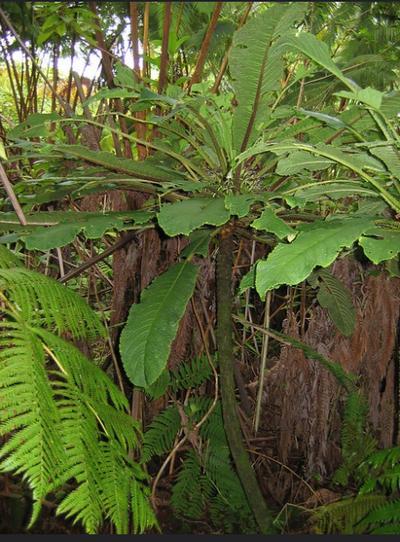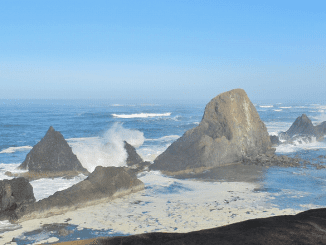
HONOLULU, Hawai’i, March 12, 2024 (ENS) – The U.S. Fish and Wildlife Service Monday designated 119,326 acres as protected critical habitat for 11 plants and a Hawaiian picture-wing fly found only on the Big Island of Hawai‘i. All 12 species are listed as endangered under the U.S. Endangered Species Act.
The protected habitat is in 21 different areas – from the coast through dry forest and grasslands to rainforests on the slopes of the volcanic mountains Mauna Kea and Mauna Loa.
The protections come in response to litigation brought by the Center for Biological Diversity, a national, nonprofit conservation organization with more than 1.7 million members based in based in Tucson, Arizona, with offices across the mainland United States.
“This is terrific news. There’s just no way to save these severely endangered species without protecting and restoring the places they call home,” Maxx Phillips, Hawai‘i director at the Center for Biological Diversity said. “Protecting habitat is a crucial step, but more needs to be done to address threats from fire, development and invasive species like rats and non-native grasses.”
But, the Center points out, there is one whole family of endangered flowers that was left out of the ESA’s protective designation.
The U.S. Department of Defense’s Pōhakuloa Training Area was excluded from critical habitat even though it is the only place on Earth where the māʻoliʻoli plant, or schiedea hawaiiensisi, is found. This perennial herb or vine is in the pink family, Caryophyllaceae, a genus of flowering plants native to Hawaii.
This family of plants contains 34 species. A 35th species was spotted in 2017 during a survey of a forest near Laupāhoehoe on Hawai‘i Island, but it has yet to be named.
The Center is disappointed that these native Hawaiian flowers are not being protected. “The dry forests these rare flowers need to survive are threatened by fires caused by the military’s training activities at the Pōhakuloa Training Area,” the group said.
Pohakuloa Training Area includes a portion of the last remaining sub-alpine tropical dryland ecosystem in the world. There are 20 federally-listed species found at the installation (16 plants and 4 animals).
Critical habitat was instead designated on the adjacent Pu‘u Anahulu Game Management Area over the objections of the state. This area, as well as another game management area at Pu‘u Wa‘awa‘a, were the subject of a habitat conservation plan drafted by the state in 2017, but never finalized.
“Hawai‘i’s forest, grassland and coastal habitats are breaking down before our very eyes under the relentless onslaught of invasive species and destructive development,” said Phillips. “My heart is breaking at the loss of so many of our plants and animals that can be found nowhere else on the planet. We have to make restoring these critical habitat areas our highest priority.”
Of the 12 species in the listing, 11 are plants and one is a picture-wing fly. The critical habitat occurs across six ecosystems on the island of Hawaiʻi: mesic forest, mesic grasslands and shrublands, wet forest, wet grasslands and shrublands, coastal, and dry forest.
Each species faces threats of habitat loss and degradation due to many circumstances: introduced ungulates, fire, drought, habitat-modifying invasive plants, and predation from non-native insects.
“We grouped the 12 species in this designation based on their interconnectedness and reliance on ecosystems found only on the island of Hawaiʻi,” said Lasha-Lynn Salbosa, Pacific Islands Fish and Wildlife Office listing and classification manager.
The Fish and Wildlife Services offers a short description of each species, alphabetized by scientific name:

- – Bidens hillebrandiana ssp. hillebrandiana (koʻokoʻolau) is a short-lived perennial herb that occurs in coastal and dry cliff ecosystems on rocky substrate near the shoreline. It is found on the windward eastern coast of Kohala near the northern tip of the island.
- – Cyanea marksii (hāhā) is a short-lived perennial, shrub or palm-like tree and is found on the west side of the island in the district of South Kona.
- – Cyanea tritomantha (‘akū) is a palm-like shrub distributed across the windward slopes of Mauna Kea, Mauna Loa, Kīlauea, and the Kohala Mountains.
- – Cyrtandra nanawaleensis (ha‘iwale) is a shrub or small tree found in wet forest ecosystems in the Puna district.
- – Cyrtandra wagneri (ha‘iwale, kanawao ke‘oke‘o) is a shrub or small tree found in wet forest ecosystems along the northeast side of the island.
- – Melicope remyi (no common name) is a long-lived perennial shrub found on the windward slopes of the Kohala Mountains and Mauna Kea.
- – Phyllostegia floribunda (no common name) is a perennial shrub found in mesic forest and wet forest ecosystems along the eastern side of the island.
- – Pittosporum hawaiiense (hōʻawa, hāʻawa) is a small tree found in mesic and wet ecosystems on the island.
- – Schiedea diffusa ssp. macraei (no common name) is a perennial climbing herb found in the wet forest ecosystem of the Kohala Mountains and the windward slopes of Mauna Loa.
- – Schiedea hawaiiensis (māʻoliʻoli) is a perennial herb, and at the time of listing, occurs only at a single site in dry forest habitat between Mauna Loa and Mauna Kea mountains.
- – Stenogyne cranwelliae (no common name) is a vine found in the Kohala Mountains in wet forest habitat.
The Hawaiʻi picture-wing fly, Drosophila digressa, has historically been found in five locations on the island in elevations from 2,000 to 4,500 feet in mesic forest and wet forest habitats.

Critical habitat is a tool of the Endangered Species Act that supports the continued conservation of imperiled species by guiding cooperation within the federal government.
Identifying critical habitat also informs landowners and the public which specific areas are important to a species’ conservation and recovery. The Service can also make the determination to not designate critical habitat when a designation would likely increase the threat of collection, vandalism, or incidental habitat degradation.
The Service declined to designate critical habitat for two more imperiled species, the loulu palm, Pritchardia lanigera,, and ʻopāe pond shrimp, Vetericaris chaceorum.
The Service claimed that designating critical habitat may increase the likelihood these species would be taken by collectors.
Feature image: This photo, taken between 2007 and 2014 at Pohakuloa Training Area, PTA, on Hawaii Island, is of the rare but still unprotected endemic plant Schiedea hawaiiensis (māʻoliʻoli). (Photo by PTA Natural Resources Office)
© 2024, Environment News Service. All rights reserved. Content may be quoted only with proper attribution and a direct link to the original article. Full reproduction is prohibited.



